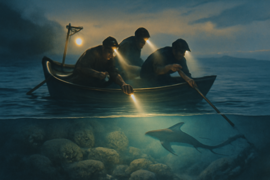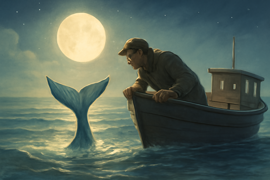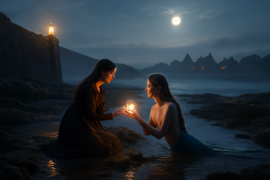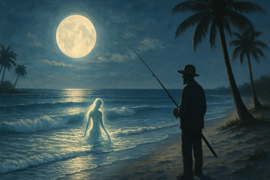Introduction
Palm Harbor rests along the Gulf Coast of Florida, a place where swaying palms cast long shadows over quiet inlets and crystalline water laps gently against white sand. In this serene bay, fishermen mend nets at dawn and children build sandcastles beneath the noon sun, yet a timeless mystery lies just below the waves. Locals speak in hushed tones of a haunting melody carried by the evening breeze, a song so sweet it lingers in the mind long after the sea has fallen silent. They say that on the darkest nights, when the moon hangs low and the clouds part in silver slivers, shapes emerge from the surf—figures with luminous eyes and hair like dripping seaweed, bodies that glisten under starlight. Families pass down these stories from one generation to the next, weaving a tapestry of wonder that binds the community to the water’s edge. No one can agree on whether these beings are spirits of lost sailors, guardians of the Gulf, or something older still. But every year, as the tides shift and the moon grows full, Palm Harbor holds its breath, hoping for a glimpse of the creatures that sing beneath the waves.
Whispers Beneath the Waves
The earliest murmurs of mermaid sightings around Palm Harbor trace back to the late nineteenth century, when pioneering settlers first navigated these shallow inlets in wooden skiffs. A logbook entry from 1887 describes a young deckhand who swore that at twilight he heard a voice rising above the sea’s hush. He abandoned his post, peering over the rail as a face—pale and illuminated by fireflies—hovered just below the surface. When he blinked, the apparition sank beneath the waves, leaving only salt-sprayed silence and a heart pounding with disbelief. Word spread quickly among the small fishing community, and soon every captain and deckhand watched the horizon in yearning anticipation, convinced that mermaids roamed these waters at night.

An elderly storyteller named Henrietta Monroe, whose family arrived on Florida’s coast in 1882, claimed her grandmother once saw three mermaids dancing around a cluster of rocks at dawn. She described them as lithe and graceful, their tails tinged with emerald and silver scales that caught the first light like fragments of a broken mirror. Swallowed by the surf before breakfast, they left her with a single strand of seaweed woven into a braid of her hair—a token she kept until her dying day. Though skeptics dismissed her tale, many in Palm Harbor believe that treasured relic still lies hidden in an attic trunk, waiting to confirm the legend’s validity.
Across generations, fishermen changed their routines to honor the unseen residents of these bays. They offered small tributes—shells polished smooth by tides—and sang lullabies when the moon was fullest, hoping to appease the mermaids or merely to attract their attention. Nautical charts were adorned with careful sketches of underwater caves said to be meeting places for sea folk. Even scientists who visited to test water samples recorded inexplicable sonar readings, as if enormous figures drifted just out of view, haunting the deeper channels.
Every family in town has a story of a stolen trinket or a hushed warning: never go into the water alone when the tide pulls in under a new moon. Yet alongside fear, there exists profound respect. Mermaids are woven into festivals and murals, inspiring an annual Harvest by the Bay celebration at dusk, where lanterns float on the water’s surface to guide friendly spirits back home. Children learn mermaid songs as lullabies, and while some tune them out as simple bedtime tales, others swear the lyrics echo on wind-whipped waves.
Today, the fishermen’s tales have merged with modern fascination. Diving tours offer “mermaid safaris” by day, scanning reefs for glimpses of tails swishing beneath foam. Marine biologists occasionally join with high-tech cameras, only to return with footage of shadows darting away in the blue. Palm Harbor’s tourism thrives on the blend of science and superstition, while tonight’s storytellers prepare for the moonrise, certain that the legends live on in every crest and trough of the Gulf’s gentle heart.
Moonlit Encounters and Fishermen's Tales
Local folklore records several particularly vivid moonlit encounters, each adding fresh layers to the mermaid legend. In 1923, Captain Elias Harding returned ashore with saltwater dripping from his coat pockets and eyes wide with wonder. He told of rescuing a drowning seagull tangled in netting, only to look up and see a mermaid perched on his bow. She held the bird gently, her fingers brushing its feathers before releasing it into night air. Harding swore she locked eyes with him and let out a soft trill, like a half-forgotten lullaby, before slipping beneath the cresting waves.

That singular event inspired new rituals. Fishermen declared the moment auspicious: any rescued creature might carry a mermaid’s blessing. Soon townsfolk were scrambling to free starfish from rocky grooves, remove jellyfish washed ashore, and offer pearls of light reflected on broken shells as gifts of gratitude. The bay walls were hung with ribbons in sea green and pearl white, fluttering like mermaid fins in every breeze. When the moon climbs high, these ribbons dance in reflection of tales old and new, guiding storytellers along a path braided with salt and sentiment.
By the mid-twentieth century, photographers ventured onto the dunes prepared to capture the uncanny. Under a full moon’s glow, one tourist snapped a spiral of water that arched above his head just as his camera clicked. In the development lab, he found an indistinct form entwined in foam, half-human and fantastical by any measure. Film dinners at Palm Harbor’s lone café became grand presentations, with townsfolk huddled over murky snapshots, gasping at the outlines of hips and tails and outstretched hands inviting the world to believe.
As radio programs and newspapers picked up the tales, Palm Harbor found itself on the map—not just for its fishing grounds, but for the coastal mystery that thrived at twilight. Tourists arrived by bus and boat, hoping to witness something the locals treated as sacred ritual. They hurried to clap eyes on glittering scales at the water’s edge, though most found only sea foam and moonbeams. Yet even failure enriched the legend: a disappointed gasp, a turned smile, a grateful heart warmed by the sense of possibility that ran deeper than any tide.
Even skeptics admitted there was magic in simply believing. And so, under every moonlit sky, the community of Palm Harbor gathers to tell stories that ripple outward like gentle waves—stories that remind them of their bond with the sea, the enduring power of wonder, and the mermaids who sing of ages past and dreams still to come.
The Heart of the Legend: Merfolk’s Gifts and Warnings
Beyond the allure of sight and song, mermaid folklore in Palm Harbor extends into cautionary whispers and whispered blessings. Elders explain that these sea spirits are not mere curiosities but custodians of fragile ecosystems. Tales tell of mermaids guiding fishermen away from overfished reefs, or flicking warning glances to those who would trespass upon turtle nesting grounds. In this way, the legend serves as an early form of environmental stewardship, reminding humans that every scoop of sand dislodged and every net cast too wide can upset a delicate balance beneath the surface.

One story recounts a merchant vessel stranded during a sudden squall, its keel lodged on a hidden shoal. Desperate cries echoed across the deck until a squadron of mermaids surfaced, their arms raised high, beckoning for crew members to follow. Silk-like hair wound with shell and seaweed marked their arrival, and they navigated the sailors through a labyrinth of submerged rocks and swells. When dawn colored the horizon, the rescued crew found their vessel safely afloat in deep water, untouched by harm. Ever since, Palm Harbor fishermen whistle an old mermaid tune to coax friendly currents during rough nights.
But mermaids can also bear stern rebuke. When a coastal landowner drained marshlands to build a beachfront mansion in the 1940s, eyewitnesses reported strange occurrences: nets full of tangled shrieks instead of fish, lanterns that flickered out at sea, and midnight tremors beneath the sand. Locals say mermaids summoned low tides at the new docks, stranding vessels until the builder relented and restored the wetlands. Such stories underscore that these creatures are neither entirely benevolent nor malevolent—they mirror human intent, nourishing those who respect the sea and warning those who defile it.
In modern times, community groups have adopted the mermaid legend to promote conservation. Schoolchildren plant mangroves and clean beaches in honor of their mythical protectors. Art installations of sculpted merfolk emerge at shoreline parks, each plaque telling a chapter of the folktale. Palm Harbor Medical Center even named a pediatric wing "The Sea’s Embrace," with murals depicting friendly mermaids cradling newborns, symbolizing healing through harmony with nature.
Thus, the legend of Palm Harbor’s mermaids lives on as both enchantment and admonition. It reminds every generation that beneath the Gulf Coast’s serene veneer lies a living realm of wonder—one that rewards respect with gentle guidance and warns neglect with haunting song.
Conclusion
As the tide recedes each dawn, Palm Harbor returns to its quiet rhythms—nets hung to dry, beach umbrellas folded, and seagulls wheeling overhead. Yet the memory of moonlit splendor lingers in every shell and ripple. The legend of the mermaids endures not merely as a curious tale, but as a living tradition that shapes local customs, tourism, and environmental stewardship. It teaches that wonder and responsibility share the same waters: to cherish the sea is to honor its mysteries, and to heed the legend is to safeguard future shores. Tonight, as you trace the shoreline under a waning moon, listen closely for the distant song and be part of a legacy that flows from the deep and returns, echoing, to every heart that believes in magic beneath the waves. It is here in Palm Harbor that ancient legend and modern life meet—where every wave carries a story, and every starlit ripple might unveil the glimmer of a tail that vanished only moments before, reminding us that some mysteries remain forever just out of reach, yet forever within our dreams and our sense of wonder by the sea.

















